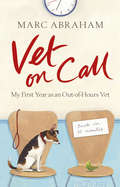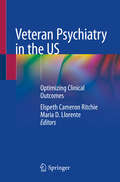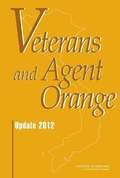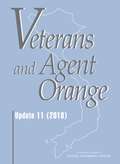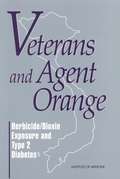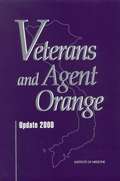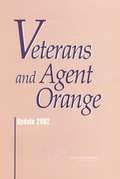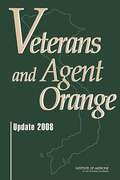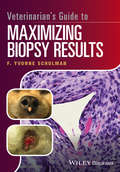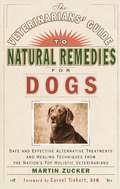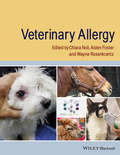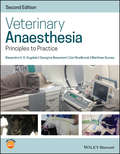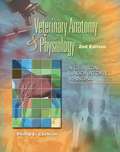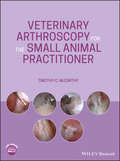- Table View
- List View
Vet at the End of the Earth: Adventures with Animals in the South Atlantic
by Jonathan HollinsThe passionate story of a vet&’s care for all creatures great and small in the colorful, diverse, and distinctive South Atlantic islands.The role of a resident vet in the remote islands of the Falklands, St. Helena, Ascension, and Tristan da Cunha encompasses many wonderful complexities: caring for the world&’s oldest living land animal (a 200-year-old giant tortoise, denizen of the St. Helena governor&’s lawn); pursuing mystery creatures and invasive microorganisms; relocating herds of reindeer; and rescuing animals in extraordinarily rugged landscapes, from subtropical cloud forests to volcanic cliff faces. Hugely entertaining and affectionate, Jonathan Hollins&’s tales of island vet life are not only full of ingenuity and astounding fauna—they are also steeped in the unique local cultures, history, and peoples of the islands, far from the hustle of continental life. Come join Jonathan on his daily adventures with these alluring and fascinating creatures.
Vet on Call: My First Year as an Out-of-Hours Vet
by Marc AbrahamWhen his father sat him down and told him to 'make something' of himself, young vet Marc Abraham decided to do it the hard way - by setting up an emergency 'out of hours' clinic. If getting used to the long night shifts wasn't bad enough, emergency cases are rarely straightforward. Whether it was dog who swallowed golf balls, or a gerbil in urgent need of a caesarean, every case had the potential for heartbreak. But animals and their owners could also be hilarious, such as the breeder who unwittingly gave his German Shepherd four testicles. . .Over the course of twelve tough months, the clinic began to flourish. Would Marc finally make something of himself after all?Marc Abraham writes guilelessly about his early mistakes, and the terror and joy involved in saving an animal's life. His memoir is a heart-warming, compelling and thoroughly entertaining look at the life of a vet on call.
Veteran Psychiatry in the US: Optimizing Clinical Outcomes
by Elspeth Cameron Ritchie Maria D. LlorenteThis volume explores the unique psychiatric needs of active and former military personnel and offers clinical pearls for the optimal delivery of care for these individuals. Written by experts in military and veteran psychiatry, this book addresses the most common issues in military and veteran patients, including depression, traumatic brain injury, posttraumatic stress disorder, substance use disorder, homelessness, and suicidality. Chapters highlight the characteristics of veterans suffering from each disorder that requires special treatment, making it a valuable resource for both military and civilian clinicians. Veteran Psychiatry in the US is a valuable resource for all mental health clinicians working with or seeking to work with veterans, including psychiatrists, neurologists, primary care physicians, psychologists, counselors, social workers, nurses, residents, and all others.
Veteran and Military Mental Health: A Clinical Manual
by Christopher H. Warner Carl A. CastroThis book addresses mental health treatment for veterans and active military personnel. In addition to examining foundational practices in the sub-field, it contains specifically tailored content concerning the recent collapse of the United States (US) installed Afghanistan government. The book is conscious of the myriad of complex emotions that veterans who fought for the past twenty years may be experiencing. Organized into four parts, the book begins with the foundations of veteran and military mental health culture as patients transition from active duty to veteran status, understand the present stigma and barriers to care and reflect on their deployment experience. Part two delves into the specifics of the healthcare system in which military personnel find themselves at various points in their career, including deployment and returning home. Following this, chapters examine the critically unique conditions found in patients, such as sleep disorders, traumatic brain injury, homelessness, substance abuse, and sexual trauma. The book closes with discussions on veterans and their families that focus on the effects of deployment on a military person’s loved ones and their mental state upon returning home. Timely, socially conscious, and comprehensive, the Clinical Manual on Veteran and Military Mental Health is an invaluable resource for mental health professionals receiving new military personnel patients and who have seen a significant shift in their patients due to recent events.
Veterans and Agent Orange
by Committee to Review the Health Effects in Vietnam Veterans of Exposure to HerbicidesFrom 1962 to 1971, the US military sprayed herbicides over Vietnam to strip the thick jungle canopy that could conceal opposition forces, to destroy crops that those forces might depend on, and to clear tall grasses and bushes from the perimeters of US base camps and outlying fire-support bases. Mixtures of 2,4-dichlorophenoxyacetic acid (2,4-D), 2,4,5-trichlorophenoxyacetic acid (2,4,5-T), picloram, and cacodylic acid made up the bulk of the herbicides sprayed. The main chemical mixture sprayed was Agent Orange, a 50:50 mixture of 2,4-D and 2,4,5-T. At the time of the spraying, 2,3,7,8-tetrachlorodibenzo-p-dioxin (TCDD), the most toxic form of dioxin, was an unintended contaminant generated during the production of 2,4,5-T and so was present in Agent Orange and some other formulations sprayed in Vietnam. Because of complaints from returning Vietnam veterans about their own health and that of their children combined with emerging toxicologic evidence of adverse effects of phenoxy herbicides and TCDD, the National Academy of Sciences (NAS) was asked to perform a comprehensive evaluation of scientific and medical information regarding the health effects of exposure to Agent Orange, other herbicides used in Vietnam, and the various components of those herbicides, including TCDD. Updated evaluations are conducted every two years to review newly available literature and draw conclusions from the overall evidence. "Veterans and Agent Orange: Update 2012" reviews peer-reviewed scientific reports concerning associations between health outcomes and exposure to TCDD and other chemicals in the herbicides used in Vietnam that were published in October 2010--September 2012 and integrates this information with the previously established evidence database. This report considers whether a statistical association with herbicide exposure exists, taking into account the strength of the scientific evidence and the appropriateness of the statistical and epidemiological methods used to detect the association; the increased risk of disease among those exposed to herbicides during service in the Republic of Vietnam during the Vietnam era; and whether there exists a plausible biological mechanism or other evidence of a causal relationship between herbicide exposure and the disease.
Veterans and Agent Orange (2018): Update 11 (2018)
by Engineering Medicine National Academies of SciencesFrom 1962 to 1971, the U.S. military sprayed herbicides over Vietnam to strip the thick jungle canopy that could conceal opposition forces, to destroy crops that those forces might depend on, and to clear tall grasses and bushes from the perimeters of US base camps and outlying fire-support bases. Mixtures of 2,4-dichlorophenoxyacetic acid (2,4-D), 2,4,5-trichlorophenoxyacetic acid (2,4,5-T), picloram, and cacodylic acid made up the bulk of the herbicides sprayed. The main chemical mixture sprayed was Agent Orange, a 50:50 mixture of 2,4-D and 2,4,5-T. At the time of the spraying, 2,3,7,8-tetrachlorodibenzo-p-dioxin (TCDD), the most toxic form of dioxin, was an unintended contaminant generated during the production of 2,4,5-T and so was present in Agent Orange and some other formulations sprayed in Vietnam. Because of complaints from returning Vietnam veterans about their own health and that of their children combined with emerging toxicologic evidence of adverse effects of phenoxy herbicides and TCDD, the National Academies of Sciences, Engineering, and Medicine was asked to perform a comprehensive evaluation of scientific and medical information regarding the health effects of exposure to Agent Orange, other herbicides used in Vietnam, and the various components of those herbicides, including TCDD. Updated evaluations were conducted every two years to review newly available literature and draw conclusions from the overall evidence. Veterans and Agent Orange: Update 11 (2018) examines peer-reviewed scientific reports concerning associations between various health outcomes and exposure to TCDD and other chemicals in the herbicides used in Vietnam that were published between September 30, 2014, and December 31, 2017, and integrates this information with the previously established evidence database.
Veterans and Agent Orange: Herbicide/Dioxin Exposure and Acute Myelogenous Leukemia in the Children of Vietnam Veterans
by Committee to Review the Health Effects in Vietnam Veterans of Exposure to HerbicidesA report on Herbicide/Dioxin Exposure and Acute Myelogenous Leukemia in the Children of Vietnam Veterans
Veterans and Agent Orange: Herbicide/Dioxin Exposure and Type 2 Diabetes
by Institute of MedicineIn response to the concerns voiced by Vietnam veterans and their families, Congress called upon the National Academy of Sciences (NAS) to review the scientific evidence on the possible health effects of exposure to Agent Orange and other herbicides. This call resulted in the creation of the first NAS Institute of Medicine Committee to Review the Health Effects in Vietnam Veterans of Exposure to Herbicides in 1992. The committee published its initial findings in the 1994 report Veterans and Agent Orange: Health Effects of Herbicides Used in Vietnam. This report is the result of a 1999 request from the Department of Veterans Affairs (DVA) under the aegis of the Veterans and Agent Orangeresearch program. Specifically, DVA asked the committee to examine evidence regarding the association, if any, between Type 2 diabetes and exposure to dioxin and other chemical compounds in herbicides used in Vietnam. Veterans and Agent Orange: Herbicide/Dioxin Exposure and Type 2 Diabetesreviews the scientific evidence regarding the association, if any, between Type 2 diabetes1 and exposure to dioxin2 and other chemical compounds in herbicides used in Vietnam. This report examines, to the extent that available data permitted meaningful determinations, (1) whether a statistical association with herbicide exposure exists, taking into account the strength of the scientific evidence and the appropriateness of the statistical and epidemiologic methods used to detect the association; (2) the increased risk of the disease among those exposed to herbicides during Vietnam service; and (3) whether there is a plausible biological mechanism or other evidence of a causal relationship between herbicide exposure and the disease.
Veterans and Agent Orange: Length of Presumptive Period for Association Between Exposure and Respiratory Cancer
by Committee to Review the Health Effects in Vietnam Veterans of Exposure to HerbicidesThe federal government operates six major health care programs that serve nearly 100 million Americans. Collectively, these programs significantly influence how health care is provided by the private sector. Leadership by Example explores how the federal government can leverage its unique position as regulator, purchaser, provider, and research sponsor to improve care--not only in these six programs but also throughout the nation's health care system. The book describes the federal programs and the populations they serve: Medicare (the elderly), Medicaid (low income patients), SCHIP (children), VHA (veterans), TRICARE (individuals in the military and their dependents), and IHS (native Americans). It then examines the steps each program takes to assure and improve safety and quality of care. The Institute of Medicine proposes a national quality enhancement strategy focused on performance measurement of clinical quality and patient perceptions of care. The discussion on which this book focuses includes recommendations for developing and pilot-testing performance measures, creating an information infrastructure for comparing performance and disseminating results, and more. Leadership by Example also includes a proposed research agenda to support quality enhancement. The third in the series of books from the Quality of Health Care in America project, this well-targeted volume will be important to all readers of To Err Is Human and Crossing the Quality Chasm--as we
Veterans and Agent Orange: Update 2000
by Naval Studies Board National Research CouncilVeterans and Agent Orange: Update 2000 examines the state of the scientific evidence regarding associations between diseases and exposure to dioxin and other chemical compounds in herbicides used in Vietnam. It is the fourth in a series of comprehensive reviews of epidemiologic and toxicologic studies of the agents used as defoliants during the Vietnam War. Over forty health outcomes in veterans and their children are addressed.Among the report's conclusions is that there is sufficient evidence of a link between exposure and the development of soft-tissue sarcoma, non-Hodgkin's lymphoma, Hodgkin's disease, and chloracne in veterans. Additionally, it found that scientific studies offer "limited or suggestive" evidence of an association with other diseases in veterans—including Type 2 diabetes, respiratory cancers, prostate cancer, multiple myeloma and some forms of transient peripheral neuropathy—as well as the congenital birth defect spina bifida in veterans' children.
Veterans and Agent Orange: Update 2002
by Committee to Review the Health Effects in Vietnam Veterans of Exposure to HerbicidesThe federal government operates six major health care programs that serve nearly 100 million Americans. Collectively, these programs significantly influence how health care is provided by the private sector. Leadership by Example explores how the federal government can leverage its unique position as regulator, purchaser, provider, and research sponsor to improve care--not only in these six programs but also throughout the nation's health care system. The book describes the federal programs and the populations they serve: Medicare (the elderly), Medicaid (low income patients), SCHIP (children), VHA (veterans), TRICARE (individuals in the military and their dependents), and IHS (native Americans). It then examines the steps each program takes to assure and improve safety and quality of care. The Institute of Medicine proposes a national quality enhancement strategy focused on performance measurement of clinical quality and patient perceptions of care. The discussion on which this book focuses includes recommendations for developing and pilot-testing performance measures, creating an information infrastructure for comparing performance and disseminating results, and more. Leadership by Example also includes a proposed research agenda to support quality enhancement. The third in the series of books from the Quality of Health Care in America project, this well-targeted volume will be important to all readers of To Err Is Human and Crossing the Quality Chasm--as we
Veterans and Agent Orange: Update 2008
by Institute of Medicine of the National AcademiesFrom 1962 to 1971, the U.S. military sprayed herbicides over Vietnam to strip the thick jungle canopy that could conceal opposition forces, to destroy crops that those forces might depend on, and to clear tall grasses and bushes from the perimeters of U.S. base camps and outlying fire-support bases. In response to concerns and continuing uncertainty about the long-term health effects of the sprayed herbicides on Vietnam veterans, Veterans and Agent Orange provides a comprehensive evaluation of scientific and medical information regarding the health effects of exposure to Agent Orange and other herbicides used in Vietnam. The 2008 report is the eighth volume in this series of biennial updates. It will be of interest to policy makers and physicians in the federal government, veterans and their families, veterans' organizations, researchers, and health professionals.
Veterinarian's Guide to Maximizing Biopsy Results
by F. Yvonne SchulmanVeterinarian's Guide to Maximizing Biopsy Results helps veterinary practitioners in obtaining high-quality biopsy samples, maximizing the results and minimizing the cost. Details the biopsy process step by step Includes a submission checklist to assure thoroughness Helps clinicians avoid errors when collecting biopsy samples Ensures high-quality samples for improved results and reduced costs Provides practical, clinically oriented information
Veterinarians Guide to Natural Remedies for Dogs: Safe and Effective Alternative Treatments and Healing Techniques from the Nation's Top Holistic Veterinarians
by Martin ZuckerNatural Remedies for Dogs by Vets
Veterinary Allergy
by Aiden P. Foster Chiara Noli Wayne RosenkrantzThe current state of knowledge on this increasingly important subject is beautifully described in this, the first truly comprehensive text of allergic diseases affecting the major veterinary species. It will be an invaluable guide to students, clinicians and researchers alike. From the Foreword by Professor Richard Halliwell, MS, PhD, VetMB, MRCVS, Dip ACVDVeterinary Allergy is the first comprehensive, high quality reference dealing with all aspects of veterinary allergy in all species and all body systems involved with allergy. Providing solid breadth and excellent depth of coverage, it deals with the immunopathology of the various allergic conditions as well as with clinical presentation, diagnosis and treatment of veterinary allergic diseases.Key features:Broad species coverage, organised by sections on dogs, cats, horses, and other domestic species including large animals, birds and small mammalsProvides details on diseases affecting the skin, respiratory tract and gutContains practical information for clinicians on management of allergic diseasesIncludes fully-referenced high level detail suitable for specialists and researchersFocused on evidence-based medicine and scienceThe editors have extensive experience and are respected as world-wide experts in the fieldEvery chapter is written by an expert in that particular topicAnyone seeking information and references on any aspect of allergic conditions in any species should find this book helpful. The book will be of interest to clinicians in first opinion practice, specialists in veterinary dermatology, gastroenterology, internal medicine, and immunology as well as specialists-in-training in those fields and veterinary students.The focus on underlying principles and practical clinical aspects is admirable. Immediately useful for practical utilization by practicing clinicians. Dr. Andrew Mackin BSc BVMS MVS DVSc FACVSc DSAM, Diplomate, American College of Veterinary Internal Medicine, Professor and Service Chief, Small Animal Internal Medicine, Dr. Hugh G. Ward Endowed Chair of Small Animal Veterinary Medicine, College of Veterinary Medicine, Mississippi State University, USA
Veterinary Anaesthesia: Principles to Practice
by Alexandra DugdaleThis comprehensive textbook covers the key principles of veterinary anaesthesia and encompasses a wide range of species. Information is summarised in a simple, reader-friendly format, while still providing the detail you need for an advanced level of study. The easy-reference structure is designed to help you identify and access topics of interest quickly. Over 180 photographs and line drawings illustrate the scientific principles, equipment and the techniques you need to know. A self-test section at the end of every chapter helps you to learn and revise each topic. As well as the technical and species-based chapters, you will find useful chapters that you can refer to as part of your daily practice: Quick Reference Guide to Analgesic Infusions Trouble-shooting for common problems encountered in anaesthetised patients Anaesthetic Machine Checks Canine, Feline and Equine Emergency Drug Dose Charts Designed specifically for veterinary students and those preparing to take advanced qualifications in veterinary anaesthesia. It is also a useful reference for veterinarians in practice and advanced veterinary nurses and technicians.
Veterinary Anaesthesia: Principles to Practice 2nd Edition
by Alexandra H. Dugdale Georgina Beaumont Carl Bradbrook Matthew GurneyThorough revision of a comprehensive and highly readable textbook on veterinary anaesthesia A popular book amongst veterinary students and veterinary anaesthesia residents, the new edition of Veterinary Anaesthesia: Principles to Practice continues to be a comprehensive textbook covering the key principles of veterinary anaesthesia, encompassing a wide range of species. Fully revised, the information is summarised in a simple, accessible format to help readers navigate and locate relevant information quickly. Filled with technical and species-based chapters, it offers a quick reference guide to analgesic infusions, as well as emergency drug dose charts for canines, felines, and equines. Provides broad coverage of the basics of veterinary anaesthesia and how it is implemented in clinical practice Includes new information on mechanisms of general anaesthesia Features new and improved photographs and line illustrations, plus end of chapter questions to test your knowledge Covers veterinary anaesthesia for a wide range of species, including dogs, cats, horses, rabbits, donkeys, and pigs Expands example case material to increase relevance to day-to-day clinical practice Updated to contain the latest developments in the field, Veterinary Anaesthesia: Principles to Practice is designed specifically for veterinary students and those preparing to take advanced qualifications in veterinary anaesthesia. It is also a useful reference for veterinarians in practice and advanced veterinary nurses and technicians.
Veterinary Anatomy and Physiology: A Clinical Laboratory Manual (2nd Edition)
by Phillip E CochranThis text is a laboratory manual for a detailed study of comparative veterinary anatomy and physiology. Useful for veterinary technology and pre-veterinary medicine students, it covers cat dissection, sheep heart, brain and eye, and the pig's kidney. Veterinary Anatomy & Physiology and also covers the muscular, digestive, respiratory, cardiovascular, urinary, reproductive, endocrine and nervous systems, as well as the skeletal anatomy of many species and the histology of tissues.
Veterinary Anesthesia and Analgesia
by Kurt A. Grimm William J. Tranquilli Leigh A. Lamont Stephen A. Greene Sheilah A. RobertsonVeterinary Anesthesia and Analgesia: the Fifth Edition of Lumb and Jones is a reorganized and updated edition of the gold-standard reference for anesthesia and pain management in veterinary patients. Provides a thoroughly updated edition of this comprehensive reference on veterinary anesthesia and analgesia, combining state-of-the-art scientific knowledge and clinically relevant information Covers immobilization, sedation, anesthesia, and analgesia of companion, wild, zoo, and laboratory animals Takes a body systems approach for easier reference to information about anesthetizing patients with existing conditions Adds 10 completely new chapters with in-depth discussions of perioperative heat balance, coagulation disorders, pacemaker implantation, cardiac output measurement, cardiopulmonary bypass, shelter anesthesia and pain management, anesthetic risk assessment, principles of anesthetic pharmacology, and more Now printed in color, with more than 400 images
Veterinary Anesthesia and Analgesia, The 6th Edition of Lumb and Jones
by Lydia Love Sheilah Robertson Carrie Schroeder Leigh Lamont Kurt GrimmVETERINARY ANESTHESIA AND ANALGESIA A thoroughly updated new edition of the foundational reference on veterinary anesthesia and analgesia Veterinary Anesthesia and Analgesia: The Sixth Edition of Lumb and Jones is a fully updated revision to this comprehensive, authoritative reference to all aspects of veterinary anesthesia and pain management. Encompassing both scientific principles and clinical applications, the new edition adds new knowledge, techniques, and discussion of emerging issues throughout. Fourteen new chapters significantly expand the coverage of patient monitoring modalities and nociception and pain, while presenting new information on safety culture, infection prevention and control, biomedical engineering, and point-of-care ultrasound. Logically organized into sections, information on basic principles, pharmacology, specific body systems, and specific species is easy to access. Comparative anesthetic considerations for dogs and cats, horses, ruminants, swine, laboratory animals, free-ranging terrestrial mammals, marine mammals, reptiles, amphibians, fish, and birds are discussed. Chapters are devoted to anesthesia and pain management of common domestic species and patient populations, including updated chapters on local and regional anesthetic and analgesic techniques. A companion website offers video clips of point-of-care ultrasound techniques and pain assessment and scoring. Readers of Veterinary Anesthesia and Analgesia: The Sixth Edition of Lumb and Jones will also find: Significantly expanded coverage of patient monitoring, including new chapters devoted to anesthetic depth and electroencephalography, electrocardiography, blood pressure, ventilation, oxygenation, and anesthetic gas monitoring. More in-depth coverage of respiratory physiology and pathophysiology, with new sections covering oxygen therapy, mechanical ventilation, anesthetic management considerations for bronchoscopy, intrathoracic procedures, including one-lung ventilation, and patients with respiratory disease. Expanded coverage of pain physiology and pathophysiology, recognition and quantification of pain, and clinical pain management, including both pharmacologic and nonpharmacologic modalities. A companion website incorporating video clips and example pain scoring sheets to complement the more than 500 images in the text itself. With its unparalleled multidisciplinary approach, Veterinary Anesthesia and Analgesia is a must-own volume for veterinary anesthesia specialists and researchers; specialists in other disciplines, including both small and large animal surgeons; practitioners; and students.
Veterinary Anesthetic and Monitoring Equipment
by Rebecca A. Johnson Kristen G. CooleyVeterinary Anesthetic and Monitoring Equipment is the first veterinary-specific resource solely dedicated to anesthetic and monitoring equipment used in clinical practice. Offers a practical guide to anesthetic and monitoring equipment commonly used in veterinary medicine Provides clinically oriented guidance to troubleshooting problems that may occur Discusses general principles applicable to any equipment found in the practice Presents information associated with novel anesthetic equipment and monitors
Veterinary Aromatherapy
by Dr Nelly GrosjeanIn this simple, clear and precise book, written with Nelly's inimitable passion for her subject, everyone can discover the benefits of veterinary aromatherapy as well as invaluable advice on nutrition.The abundant good advice and sensible aromatherapy remedies provided in this book will allow you, from now on, to practice natural medicine, in accordance with the laws of nature, on all domestic animals, farm-reared animals, and animals in training or racing environments.
Veterinary Arthroscopy for the Small Animal Practitioner
by Timothy C. McCarthyVeterinary Arthroscopy for the Small Animal Practitioner delivers a practical guide to all aspects of veterinary arthroscopy for small mammals. The book covers the anatomy, techniques, joint pathology, and operative procedures of arthroscopy. The book includes a foundational introduction to basic tenets for veterinarians just beginning to use arthroscopy in their work as well as reference images for joint pathology useful to experienced practitioners. Nearly 1000 images are included in the reference, each of which illustrate one or more aspects of specific arthroscopic findings. Veterinary Arthroscopy for the Small Animal Practitioner draws on the author's 35 years of clinical arthroscopic experience and offers a thorough examination of small animal arthroscopy. The book serves as a powerful demonstration of the centrality, practicality, utility, and necessity of arthroscopic veterinary procedures. Readers will also benefit from topics like: A comprehensive introduction to, and discussion of, instrumentation, including arthroscopes, sheaths and cannulas, hand instruments, power equipment, video systems, and fluid management systems An exploration of general technique, including anesthesia, patient support, pain management, and postoperative care Multiple chapters cover the six most commonly examined joints, including shoulders, elbows, radiocarpal joints, hips, stifles, and the tibiotarsal joints Treatment of common conditions diagnosed with arthroscopy Discussion of common problems and complications seen with arthroscopy in small animal practice Ideal for veterinary orthopedic surgeons and general veterinary practitioners, Veterinary Arthroscopy for the Small Animal Practitioner also belongs on the bookshelves of veterinary surgery residents and veterinary students seeking to improve their understanding of small animal arthroscopic surgery, pathology, anatomy, and techniques.
Veterinary Assisting Fundamentals And Applications
by Robert Clark Beth VanhornVeterinary Assisting Fundamentals and Applications is a comprehensive book and reference for use by veterinary assisting students, practicing veterinary assistants, veterinary receptionists, and other supportive staff within a veterinary facility. The format allows the reader to quickly obtain resources and information regarding basic veterinary assistant principles and clinical situations. The material moves from basic to advanced information and includes the latest educational information in the industry.
Veterinary Assisting: Fundamentals & Applications
by Beth Vanhorn Robert W. ClarkVeterinary Assisting Fundamentals and Applications is a comprehensive book and reference for use by veterinary assisting students, practicing veterinary assistants, veterinary receptionists, and other supportive staff within a veterinary facility. The format allows the reader to quickly obtain resources and information regarding basic veterinary assistant principles and clinical situations. The material moves from basic to advanced information and includes the latest educational information in the industry.

